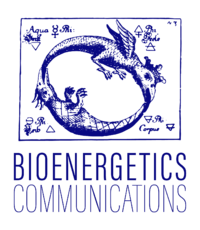From Bioblast
Revision as of 13:42, 24 April 2020 by Gnaiger Erich (talk | contribs) (Created page with "{{BEC page name}} :::: <big><big>'''Bioenergetics Communications''' is the Oroboros Ecosystem journal for publishing and sharing scientific and technical advances in bioenerge...")
- Bioenergetics Communications is the Open Science journal on bioenergetics and mitochondrial physiology with Living Communications
 - ISSN 2791-4690
- ISSN 2791-4690
BEC formats
- Bioenergetics Communications is the Oroboros Ecosystem journal for publishing and sharing scientific and technical advances in bioenergetics, mitochondrial physiology, and particularly high-resolution respirometry
:::::::: »Bioenerg Commun«
Living communications
- The concept of living communications persues a novel culture of scientific communication, addressing the conflict between long-term elaboration and validation of results and concepts, versus sharing quickly important preliminary and controversial contributions. Living communications provide a pathway along the scientific culture of lively debate towards tested and trusted milestones of research, from pre-print to re-print, from initial steps to next steps.
From preprint to publication
- The preprint is part of a stepwise process:
- MitoFit Preprint Archives is the fast lane of Open Access communication without peer review. Authors should indicate if the preprint is considered for Bioenergetics Communications.
- A MitoFit preprint posted by the authors as a potential publication in Bioenergetics Communications is immediately delegated to our Associate Editors or Section Editors:
- Communication with the authors to plan the non-anonymous Open Peer Review process. Up to three reviewers should be suggested by the authors.
BEC versions
- External review should lead quickly to publication in Bioenergetics Communications including the correspondence with the reviewer(s) as an appended discussion and reference to the preprint - without the option for reviewers to insist on additional experiments, but strict focus on the quality of the presently provided information.
- Reviewers and editors may encourage follow-up interlaboratory collaborations, with extended information added by the original authors or new collaborators; contributions by reviewers may be integrated and reviewers listed as coauthors and declared as such in the section 'Author contributions' upon mutual agreement between original authors and reviewers;
- Folow-up: Manuscripts may be updated and extended - particularly with added information and coauthors from other laboratories.
Types of communcations
Short communications
- Short communications - have the format of extended abstracts, without belonging to a specific conference. Compare: Extended_abstracts. Extended abstracts posted in MitoFit Preprint Archives in the context of any conference may be submitted to Bioenergetics Communications, if the contents is suitable.
- Comments - provide critical discussions of publications, includig summaries of journal clubs.
Communications
- Technical communications - contain instrumental and methodological details on HRR particularly focused on quality control
- Innovations - introduce tests of new instrumental developments or novel applications
- SUIT protocols - present the concept of a specific SUIT protocol, exceeding the MitoPedia description and containing more detail than typical methods sections in other publications
- Confirmatory results - demonstrate reproducibility (confirmation is the only way to do this) and add to the statistical significance of published results
- Negative results - discuss findings on methodological difficulties that failed to lead to a relevant innovation
- Regular papers - extended by the concept of living communications
- Minireviews - short overviews of recent progress in a specific area of bioenergetics and mitochondrial physiology
- Monographs - reviews and textbooks
- Topic series - communications collected according to specific research topics
Possibilities
- It is possible to publish data without statistical relevance per se, from which alone it is not possible to draw firm conclusions. Several small data sets made available from many laboratories in a methodologically consistent and reproducible way result in large data sets that are statistically even more relevant.
Discussion
- The notion of a "living publication" (Editor: "living communication") seems most applicable to this work (Editor: MitoEAGLE position paper 'States and rates') as it involves recommendations, guidelines, and references to the ever-evolving field of mitochondrial bioenergetics. This would remove the difficulties and/or concerns of individuals referring or citing older and/or outdated works, like what can happen in the US with physical activity guidelines or consensus statements. - Christopher L Axelrod 2020-04-22




